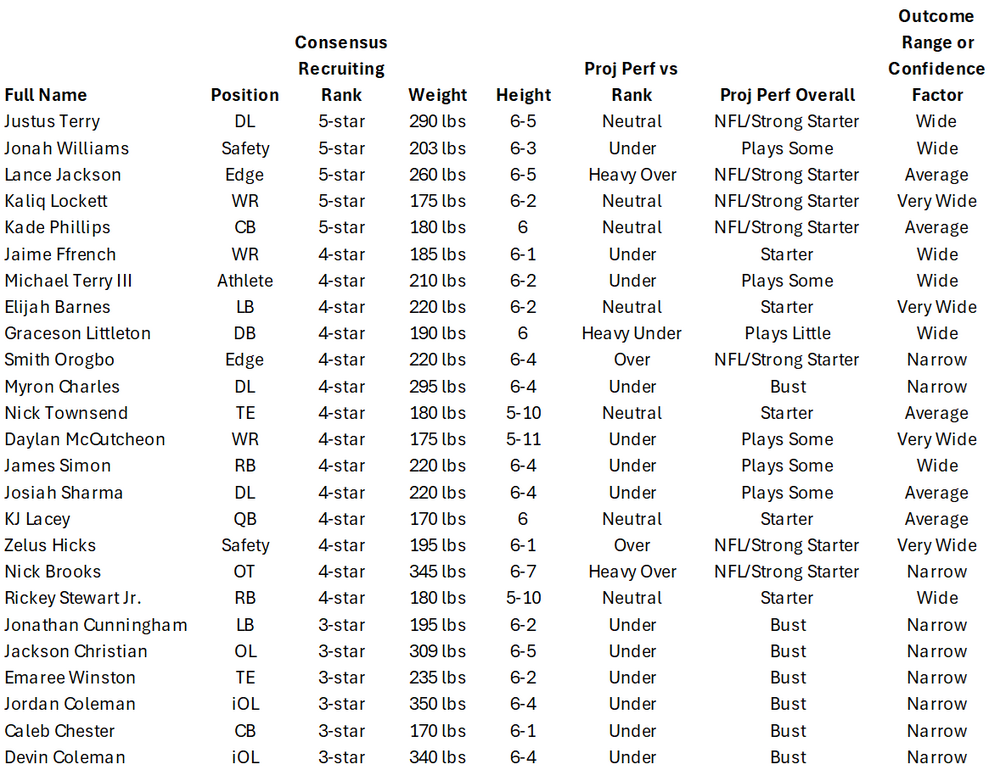Everything posted by Dbeasy
-
War with China
I dominate this game every time I play it. I should be Secretary of Defense, not the drunk.
-
The Worst Trade in NBA History: Luka traded for AD
This isn’t the worst trade in nba history. This isn’t the worst trade in sports history. This is the worst business decision in business history.
-
2024 - 2025 Dallas Mavericks Season Thread - This time we're not happy to just be here.
Yup. The Mavs have no offense at all. If they just had an all NBA superstar who is an offensive scoring machine, instead of an aging injury prone big man who’s good for a run of the mill double double, and an aging 3 point shooter who can’t hit the broad side of the barn these days.
-
The Dallas Stars 2024-2025 Season Thread: Win Now, Talk Later
I went to bed. What..the..fuck!
-
Negative Recruiting Your Own School: The aggy Screenshot Megathread
The selection of this goober as their head coach is absolutely shocking. Even for Aggie.
-
White Lotus - HBO
ya I looked up their relative ages after I typed that and found they were only 7 years apart. She looks very young in the show, and he looks like a middle aged man. Weird.
-
Markets still falling like whoa
No they haven’t. Trump’s economic policy is coming from a loon who somehow has a degree from Harvard. They haven’t thought thru shit. The entire US economy is built on the China supply chain. The amounts being handled elsewhere, like Vietnam, Mexico, etc is a pittance compared to China. While other countries can produce some goods cheaper than China, China has built a massive machine feeding the U.S. monster. It cannot be unwound in a few months. Period. And the negotiating approach being used by Trump with China is fundamentally the wrong cultural approach, by a mile. The Chinese will just dig in even deeper. I’ve written several posts about China elsewhere on the site, and there is only one way to deal with them. Build an entire alternative infrastructure elsewhere and then play them off against it mercilessly. But that takes a decade to build, and full government support. It ain’t happening. The one good news is that the US doesn’t sell a lot into China and never will, so if they eventually cut them off it won’t be that painful for most US companies. For a minority it will hurt badly.
-
Texas Recruiting Notes 2025: Duck Around and Find Out
That really hurts. I spent a lot of time and effort on this and was so looking forward to your validation. Dammit.
-
Texas Recruiting Notes 2025: Duck Around and Find Out
dammit. I had chatgpt pull the names for me. edit incoming. Also, a few comments about naming. It's school specific. Some names work at some schools but not others. All names must be evaluated in the context of the school where they are playing. It's science.
-
Texas Recruiting Notes 2025: Duck Around and Find Out
Was goofing around and reviewing the 2025 recruiting class. Over the years, I've always noticed how certain player's names just sounded like a great football player, or not. Or, their names sounded like they would either be a star, or a bust. So, just for kicks I thought I'd rate the 2025 recruiting class based upon their names. Stupid? Sure. I'll spoiler it so that those of you who have no desire to read the results can just skip over it. Here is the approach I used. First, the scientific theory behind all this. There is none. Or is there? I believe that a person's name can tell you something about who they are. Names comes from historical family tree lineage. Names reflect the parent's styles and beliefs. Names have a certain lyrical sound to them. So, maybe there is some sort of science behind projecting a person's performance based on their name. Second, I identified two predictions for each recruit. The first prediction is their performance relative to their ranking: heavily over perform, over perform, neutral, under perform, heavily under perform. The second prediction is the overall performance level they will achieve in the future: NFL quality or at least very strong starter, starter, play some, play little, bust. The Outcome Range is the potential range of outcomes for the individual, or said another way, how well does their name project the outcome. For example, some names leave you with the impression they will either end up as an NFL player, or a complete bust or anywhere in between. There is a wide range of potential outcomes. It's almost like standard deviation. Other players you feel more confident they will be a starter, but not an NFL player or a bust. That recruit has a narrow range of outcomes. It's about the range of outcomes for that player in the future: Very Wide, Wide, Average, Narrow, Very Narrow. With all of that as groundwork, here are Dbeasy's 2025 Texas Football Recruiting Player Projections. It will be fun to look back on this in 3-4 years and see how incredibly wrong I was:
-
White Lotus - HBO
I thought the whole season was a way too slow burn. Overall, it was worth watching, but I felt myself wanting more plot progress. Other random thoughts: 1. It seemed like they did a good job of capturing the complex interaction between female friends. I thought that was pretty good. 2. Parker Posey was pretty pretty good. 3. Rick's girlfriend has got a little something and has probably just cemented future roles in movies as the cute, fun, deep girl. 4. Sam Rockwell's speech was gold. 5. I would have liked to see Woody Harrelson as Rick; it would have brought more lightheardedness to a dark subject. 6. Dang, Mook is hot, but why is she attracted to a guy 15 years older than her. 7. The whole Belinda plot arc missed, from start to finish. Overall, not bad, but not great either.
-
Trump’s America
- Trump’s America
Yes. Yes I have. There are a bunch of Internet rumors that Scott Bessent is going to bail. If that happens, imo the U.S. is in serious, serious trouble. For all of Trumps idiocy, Bessent was a competent Treasury Secretary. He was the adult in a room full of mental midgets. He's supposedly so sick of Trump already, he’s had it, just like Tillerson. Without competent financial leadership, this situation could get very very scary financially. This tariff policy is the absolute worst possible action that could have been taken by our government, given the problems we currently face financially.- Depression, OCD, and whatever else ails you between the ears
I hope everyone that follows this thread can find a path to a more content life. A highly accomplished VC friend I’ve known for almost thirty years passed away at 59 in the last week after not being able to deal effectively with his challenges. Find the positives in life if you can.- College basketball coaching carousel: 2025 edition
Holy shit, he was coaching high school just six years ago. That means: 1) he has very limited college coaching experience, and 2) he hasn’t served as an assistant to anyone of value. This is truly shocking in how bad a hire this was.- Texas Basketball 2025-26: It’s Miller Time
I’m still trying to figure out whether many on this board over-rated the transfers brought in last year, or Terry just completely mismanaged them.- Negative Recruiting Your Own School: The aggy Screenshot Megathread
Wait what happened with Moser? I figured they would get him because of their NIL money vs OU.- Texas Offseason 2025 - Archmania Is Upon Us
Those boys are east bound and down, loaded up and trucking. They gonna do what they say can’t be done.- Favorite Dead Comedian
He didn’t have a ton of material or breadth, but his joke about sending uhauls to Africa, and the cameo in Back to School, are two of the funniest bits ever.- Texas A&M Recruiting 2026: The World's Drunkest Elk
- Real estate prices in top 50 metros
I’ve mentioned this several times before: 1. Texas, and Austin, have much more new build land available than many other locations, especially California. This keeps prices from extreme increases, usually. 2. But Dbeasy, Austin shot up during Covid. Yes, and this was an anomaly. While the Austin real estate market is generally healthy, there was a feeding frenzy due to big money coming in and buying up housing. Opendoor, Blackrock, etc. And, work from home led to a surge in Austin from people coming from high real estate priced markets. Both of those things have run their course. In addition, the extreme politics of the state is definitely affecting migration here. Prices went way too high too fast, and they’ve been correcting since. 3. Tech is one of the main employment and housing drivers in Austin. Austin has always been a secondary location for most tech companies with significant employment. When the economy falters, like now, Austin gets cut harder and faster than core locations. Dallas does too, but they are starting to get more self sufficient. Long term the Austin market is fine. But it’s impossible to forecast the near term because Austin has not dealt with a serious recession since 2008, and even then Texas didn’t not get hit hard in real estate during that crash.- College basketball coaching carousel: 2025 edition
- College basketball coaching carousel: 2025 edition
Wow, a state of Texas raised A&M basketball coach leaves for a basketball school that just had their coach quit because it’s an NIL mess there and a completely uncompetitive program. Buzz telling us he wanted out bad without telling us he wanted out bad.- Markets still falling like whoa
Where do you think you can get 4% tax free municipals without significant risk?- Some questions about decisions in my 401k distributions and possibly rolling into a self directed fund
There are 2 other issues with rolling 401k’s to Ira’s. First, it makes Backdoor Roth conversions (non-deductable Ira contributions that are then converted to Roth) non-viable, because of how the taxation is calculated. Second, Ira’s have less creditor protection than 401ks, which is stupid. For me neither of these issues was enough to not do it. I wanted the lower fees, better investment options, and higher control of having funds in the Ira instead of the 401k. Plus, I was with several companies so I had many 401k’s. - Trump’s America
Football ...
Basketball ...
Baseball ...
Other Sports ...
Futbol ...
🤫995🤫 ...
Gambling ...
Movies & TV ...
Music ...
Hobbies ...
Lulz ...
Food & Travel
...
Daily Texan ...
Business & Markets ...
Cloak Room ...
Help ...
For Sale ...
Board Discussion ...
Advertise...
Tailgate Donations
Back to top
Account
Navigation
Search
Configure browser push notifications
Chrome (Android)
- Tap the lock icon next to the address bar.
- Tap Permissions → Notifications.
- Adjust your preference.
Chrome (Desktop)
- Click the padlock icon in the address bar.
- Select Site settings.
- Find Notifications and adjust your preference.
Safari (iOS 16.4+)
- Ensure the site is installed via Add to Home Screen.
- Open Settings App → Notifications.
- Find your app name and adjust your preference.
Safari (macOS)
- Go to Safari → Preferences.
- Click the Websites tab.
- Select Notifications in the sidebar.
- Find this website and adjust your preference.
Edge (Android)
- Tap the lock icon next to the address bar.
- Tap Permissions.
- Find Notifications and adjust your preference.
Edge (Desktop)
- Click the padlock icon in the address bar.
- Click Permissions for this site.
- Find Notifications and adjust your preference.
Firefox (Android)
- Go to Settings → Site permissions.
- Tap Notifications.
- Find this site in the list and adjust your preference.
Firefox (Desktop)
- Open Firefox Settings.
- Search for Notifications.
- Find this site in the list and adjust your preference.










